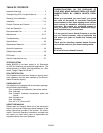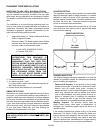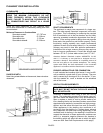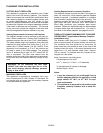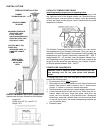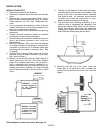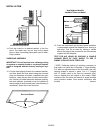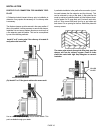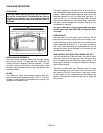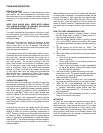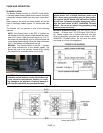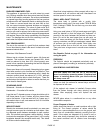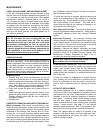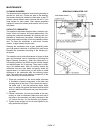
PROCUCT FEATURES AND CONTROLS
PAGE 11
BLOWER SYSTEM
The 500-CFM room air circulation blower system comes
equipped with a variable speed control (rheostat). The
blower system can be operated manually or set to oper-
ate automatically (so the blowers will turn on when the
insert is hot and turn off when the insert is cool). See
Care and Operation Section – Blower System on page
14.
PRIMARY AIR CONTROL
The primary combustion air delivery is controlled by the
primary air control draft module (The control handle is
located above the fuel door). The heat output can be
controlled by sliding the handle to a higher or lower heat
output setting (see following illustrations). The fuel, the
amount of heat and burn times desired, the type of instal-
lation are all variables that will affect the control setting.
The same control settings in a variety of installations will
produce different results. You will need to try different
settings so you can learn how much heat to expect and
how long the fire will burn
.
Lower Higher
AIR AND DAMPER CONTROLS
CATALYTIC BYPASS DAMPER CONTROL
The bypass damper control handle is located on the front
of the insert (see above illustration). By pushing in or
pulling out the handle, the operator can route the ex-
haust either through the catalytic combustor (pushed in)
or directly up the flue (pulled out). When starting a fire or
refueling, the handle must be pulled out. Once the fire is
established it must be pushed in.
CATALYTIC COMBUSTOR
How it works: From 5 to 30 percent of the chemical en-
ergy contained in every log escapes up the chimney
when wood is burned in a conventional stove. The cata-
lytic combustor is designed to make use of this energy,
converting it into useful heat as it lessens chimney creo-
sote build-up and air pollution. The catalytic combustor
consists of a durable temperature resistant ceramic com-
position, which is extruded into a cellular, or honeycomb,
configuration. After extrusion, this ceramic monolith is
fired and then covered with a noble-metal catalyst. When
wood smoke contacts this catalyst, chemical changes
occur that causes the smoke to ignite at temperatures
around 600° F. Normally, smoke will ignite and burn only
at temperatures around 1000° F.



